Eagle 1967 Indy car-by-car histories
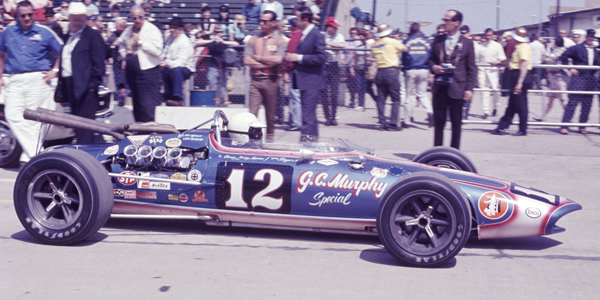
Roger McCluskey's new Eagle at the 1967 Indy 500. Part of the Dave Friedman collection. Licenced by The Henry Ford under Creative Commons licence Attribution-NonCommercial-NoDerivs 2.0 Generic. Original image has been cropped.
The 1967 Indy Eagle was only the slightest of enhancements over the 1966 model, and the chassis numbering actually continued from the earlier car. Bobby Unser's Rislone/Leader Cards car was the most successful of the batch in 1967, winning two races.
Four customer cars were delivered by Dan Gurney's All American Racers (AAR) in 1967, and were delivered to Leader Card Racers for Bobby Unser to drive, to Lindsey Hopkins for Roger McCluskey, to stock car mechanic 'Smokey' Yunick for Denny Hulme, and to John Klug's Pacesetter Homes for Jochen Rindt. The AAR team also retained two cars for its own purposes, and these were entered at the Indy 500 for Dan Gurney and Richie Ginther. Ginther could not get his car into the race and it was taken over by Friedkin Enterprises before qualifying finished, and was put into the race by Jerry Grant. Rindt wrecked his car during practice but Unser, McCluskey, Hulme and Gurney all qualified. AAR did not enter a car in the later championship races as Gurney was focused on the F1 Eagle, and his Indy 500 car was sold to AJ Foyt. Both Unser and McCluskey had good results in their cars, finishing 1-2 in each of the Mosport races, but elsewhere Mario Andretti's Hawk, Foyt's Coyote, Al Unser's Lola and even Gordy Johncock's Gerhardt proved to be quicker. Bobby Unser acquired a second 1967 Eagle and used both these cars in 1968 after his Indy 500-winning 1968 Eagle was wrecked, taking him to the 1968 USAC National Championship.
Note that there have been a number of significant changes to these histories since they were first published. The chassis numbers used here until October 2021 were based on information compiled by a research group between 2005 and 2007, and kindly provided to OldRacingCars.com in March 2009. As ORC's research into the cars progressed, it became increasingly clear that these were not entirely correct, and we eventually reached the point where the best thing to do was start again using photographic and documentary evidence only. All the histories shown here were therefore dismantled in October 2021 and were finally reconstructed in November 2022. It transpired that five of the thirteen 1966 and 1967 Eagles had been misidentified by later owners. The chassis numbers now used here are based on numbers made available from AAR records by John Zimmerman, the former Racecar, On Track, Autoweek, Sports Car and Racer journalist whose book 'Dan Gurney's Eagle Racing Cars' was published in 2007.
If you can add anything to our understanding of these cars, please contact Allen Brown (allen@oldracingcars.com).
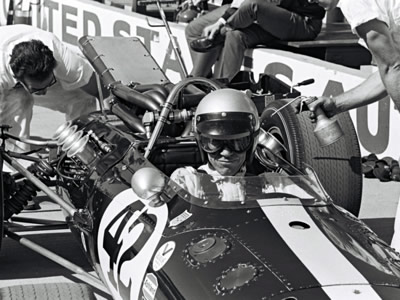
Richie Ginther in the #42 Eagle at Indianapolis in 1967 before the car was sold to Friedkin Enterprises. Part of the Dave Friedman collection. Licenced by The Henry Ford under Creative Commons licence Attribution-NonCommercial-NoDerivs 2.0 Generic. Original image has been cropped.
New for Richie Ginther at the 1967 Indy 500 as the #42 AAR entry, fitted with a Ford V8. After Ginther made two unsuccessful attempts to qualify the car was sold on 21 May to Friedkin Enterprises Racing Division for Jerry Grant to qualify, his #78 entry, a 1966 Eagle, having been bumped. The #42 car was qualified by Grant but retired from the race. Grant continued to drive for Friedkin Enterprises later in the season, using both the #78 and #42 numbers, but photographs show that his #42 car was not the AAR car he raced at the Speedway, but the team's second 1966 Eagle. Close study of photographs shows that later in 1967, the Ginther/Grant car moved to Leader Card Racers as a second 1967 Eagle for Bobby Unser to use. It can first be seen in Unser's hands at the Bobby Ball Memorial at Phoenix in November 1967, but he may have raced it earlier than that. In 1968, the team's two 1967 Eagles were very similar, but small differences indicate that this ex-Ginther/Grant car was the one Unser drove on road courses in 1968, still with its original Ford engine. In 1969, it was his regular short track car, raced at Phoenix, Hanford, Langhorne, Trenton and Milwaukee, and was his #86 backup car at the Indy 500. It is thought to be the car Unser crashed heavily at Phoenix in November 1969. Its distinctive features cannot be seen in photographs of Unser's 1967 Eagle during 1970, so its career after that accident is unknown. This car has now reappeared, but its exact provenance after the Phoenix accident is still being researched.
Driven by: Jerry Grant, Richie Ginther and Bobby Unser. First race: Indianapolis Motor Speedway (R3), 31 May 1967. Total of 16 recorded races.
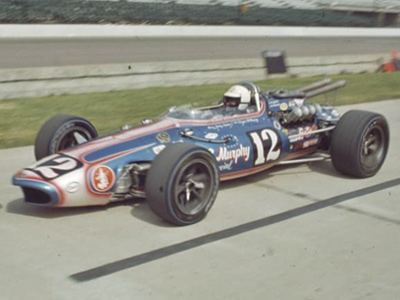
Roger McCluskey's new Eagle at the 1967 Indy 500. Part of the Dave Friedman collection. Licenced by The Henry Ford under Creative Commons licence Attribution-NonCommercial-NoDerivs 2.0 Generic. Original image has been cropped.
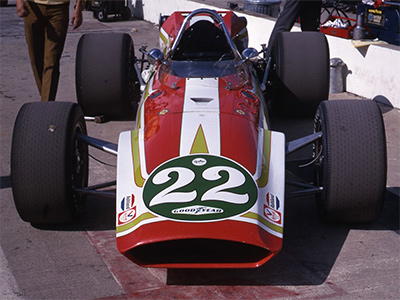
Wally Dallenbach's 1967 Hopkins Eagle at the 1969 Indy 500. Copyright Indianapolis Motor Speedway. Copyright permissions granted for non-commercial use by Indianapolis Motor Speedway.
Sold to Lindsey Hopkins, fitted with a Ford V8 and entered for Roger McCluskey as the #12 G. C. Murphy car from the start of the 1967 season. After driving this 1967 Eagle at the Indy 500, McCluskey used his 1966 Eagle at Milwaukee in June, and later at the two Mosport Park races and at Mont-Tremblant. He used his 1967 car at both Langhorne races, Milwaukee in August, Trenton in September and Hanford in October. At this latter race, McCluskey wrecked the 1967 Eagle and it would be out of service for some time. Hopkins' crew chief Jack Beckley acquired Smokey Yunick's '67 Eagle for McCluskey to drive at Phoenix, and he used the 1966 Eagle at Riverside.
One of these two 1967 Eagles was rebuilt by Beckley with Brabham front suspension for 1968, a car dubbed "Beagle" by the team, and the other was not seen again until 1969, but there remains some uncertainty which of the two cars became "Beagle". See the Beckley "Beagle".
As well as "Beagle", McCluskey raced two other cars during 1968: his original 1966 Eagle and a new 1968 Eagle. He first raced the 1968 car at the Indy 500 where some reports say that Hopkins' original 1967 Eagle was his unused #38 backup car, but this may be supposition. Bob Laycock's authoritative USAC records say that car was not entered at the Speedway in 1968 and instead shows the ex-Yunick car as McCluskey's #38 backup. If Laycock is correct, it must have been the ex-Yunick car that became "Beagle".
According to Laycock's records, the 1967 Hopkins Eagle car later returned to the Hopkins stable and was raced by new driver Wally Dallenbach at the 1969 Indy 500. Photographs show Dallenbach raced the same car at Milwaukee in June, Langhorne in June, Trenton in July, Milwaukee in August and Dover Downs in August. At Dover Downs, Dallenbach had a major crash, completely demolishing the Eagle and ending up in hospital with injuries to his face, hand and ankle.
Driven by: Roger McCluskey and Wally Dallenbach. First race: Phoenix International Raceway (R1), 9 Apr 1967. Total of 14 recorded races.
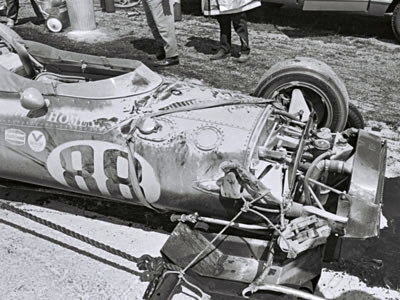
The Pacesetter Homes Eagle after it was crashed by Jochen Rindt during practice. Part of the Dave Friedman collection. Licenced by The Henry Ford under Creative Commons licence Attribution-NonCommercial-NoDerivs 2.0 Generic. Original image has been cropped.
Sold to John W. Klug, founder of California builders Pacesetter Homes, fitted with a Ford quad cam engine and entered for Jochen Rindt at the #88 car at the 1967 Indy 500. Arrived on 1 May but crashed heavily just eight days later and "damaged extensively". After the Indy 500, it was sold to Dick Smothers and repaired and fully rebuilt by Smothers' chief mechanic Roy Campbell. It was then raced by Lou Sell (Fullerton, CA) in USAC events at Continental Divide, Indianapolis Raceway Park and Mont-Tremblant in July and August 1968. It was then crashed at Riverside in December 1968 when Sell was very badly injured and the Eagle was torn in half.
The remains of this car, including the front half of the monocoque, were used in the construction of a show car. See the Don Smith Museum car.
Driven by: Jochen Rindt and Lou Sell. First race: Continental Divide (R11), 7 Jul 1968. Total of 5 recorded races.
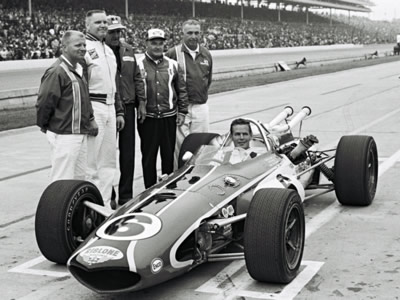
Bobby Unser's Rislone Leader Card Eagle after qualifying for the 1967 Indianapolis 500. Part of the Dave Friedman collection. Licenced by The Henry Ford under Creative Commons licence Attribution-NonCommercial-NoDerivs 2.0 Generic. Original image has been cropped.
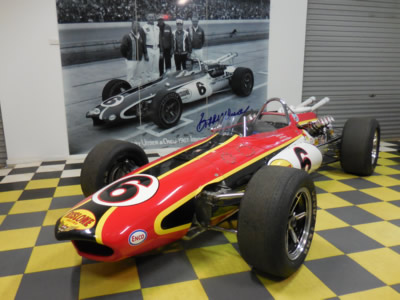
Aaron Lewis's ex-Bobby Unser 1967 Eagle following restoration. Copyright Aaron Lewis 2014. Used with permission.
Sold to the Jud Phillips half of the Leader Card team, fitted with a Ford V8 and entered for Bobby Unser as the #6 Rislone car from the start of the 1967 season. A second 1967 Eagle was acquired towards the end of 1967, and for 1968, Unser had the two 1967 Eagles and a new 1968 Eagle with Offy turbo engine which he used to win the Indy 500. Unser used his original 1967 Eagle mainly on ovals that season, with the second 1967 car set up for road courses. Unser won the 1968 USAC title using these three Eagles. All three were retained for 1969, alongside a new Lola T152 which was only raced once. After his second 1967 was heavily damaged at Phoenix in November 1969, Unser continued to race the team's original 1967 Eagle during 1970, with the 1968 Eagle being used on road courses.
When Unser and Phillips left Leader Card Racers later in 1970, their equipment was transferred to the AJ Watson half of the Leader Card team. The 1967 Eagle was raced by Watson's driver Mike Mosley to win at Trenton in April 1971, Watson's first Indycar race win in six years. It was also used by George Snider at Milwaukee, Pocono and Michigan in June and July, at Milwaukee in August and at Trenton in October.
At some point, this car was damaged, and the unrepaired monocoque was given by Watson to Bentley Warren, who raced the ex-Michner 1967 Eagle in 1972 and 1973. Warren never repaired the tub, and it remained with him until it was bought in the early 2000s, together with the ex-Michner car, by "Eagle Partners", a consortium formed by AJ Watson, Dave Thomas, Buddy Urbanski and Pat Santello. The consortium restored both cars, and the ex-Unser car, restored to its 1967 Bobby Unser livery, was sold in July 2005 to Aaron Lewis (Cessnock, NSW, Australia). Sold by Aaron in 2014 to Scott Borchetta (Nashville, TN), the founder of Big Machine Records, who ran it in the vintage event at Indianapolis in May 2015. Also appeared at the Historic Indycar Exhibition in May 2016. This car was part of the IMS Museum's "The Amazing Unsers" exhibition in 2018. At the Historic Indycar Exhibition in 2019.
Driven by: Bobby Unser, Mike Mosley and George Snider. First race: Indianapolis Motor Speedway (R3), 31 May 1967. Total of 38 recorded races.
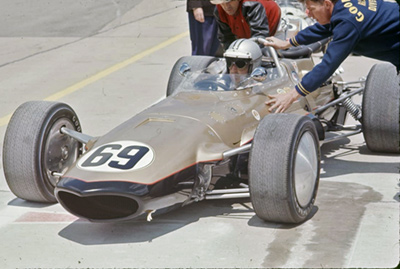
Denny Hulme heads out to practice in Smokey Yunick's new 1967 Eagle at Indianapolis. Part of the Dave Friedman collection. Licenced by The Henry Ford under Creative Commons licence Attribution-NonCommercial-NoDerivs 2.0 Generic. Original image has been cropped.
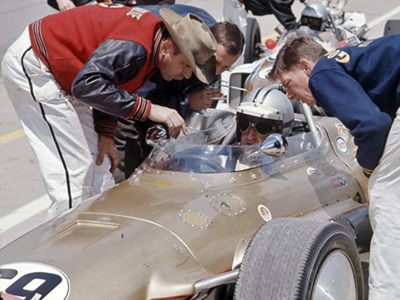
Denny Hulme in Smokey Yunick's new 1967 Eagle at Indianapolis. Part of the Dave Friedman collection. Licenced by The Henry Ford under Creative Commons licence Attribution-NonCommercial-NoDerivs 2.0 Generic. Original image has been cropped.
Bought by Goodyear who gave it to legendary NASCAR mechanic Henry "Smokey" Yunick to run for Denny Hulme at the 1967 Indy 500 as the #69 City of Daytona entry, fitted with a Ford V8. In his normal fashion, Yunick made a lot of detailed aerodynamic changes, including fairing in the front suspension and covering the exposed rivet heads in a layer of Bondo bodyfiller. Hulme finished fourth in the race but Yunick did not run the car in any other events, so the Eagle was passed to the AJ Foyt team and Foyt himself raced it at Mosport in July. As Foyt had also acquired a 1967 Eagle from AAR, the ex-Yunick car was not needed, and later in the season it passed to the Lindsey Hopkins team to replace a car that had been damaged at Hanford. Exactly how it was used in 1968 is still being researched. According to the Bob Laycock Card File, it was not entered at the Indy 500 in 1969, but reappeared in 1970 at the Indy 500 as the #37 car for Mel Kenyon, which arrived but did not go out on track. A photograph of that #37 car would be extremely useful to further our understanding of this car's history.
As we learn more about the other Lindsey Hopkins 1967 Eagle, it becomes increasingly likely that this ex-Yunick car was the Eagle rebuilt by Hopkins' chief mechanic Jack Beckley with Brabham front suspension for 1968 and named "Beagle" by the team. See the Beckley "Beagle".
Driven by: Denis Hulme, AJ Foyt and Roger McCluskey. First race: Indianapolis Motor Speedway (R3), 31 May 1967. Total of 4 recorded races.
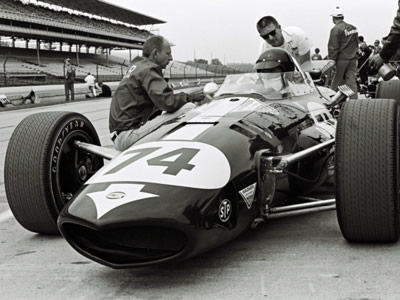
Dan Gurney in his Eagle during practice at the 1967 Indianapolis 500. Part of the Dave Friedman collection. Licenced by The Henry Ford under Creative Commons licence Attribution-NonCommercial-NoDerivs 2.0 Generic. Original image has been cropped.
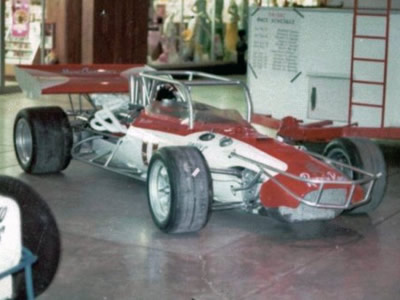
Marv Carman's supermodified Eagle on show around 1973. Copyright Jerry Entin 2009. Used with permission.
The #74 AAR entry for Dan Gurney at the 1967 Indy 500, fitted with a Ford V8 and with support from Wagner Lockheed. Sold after the race to AJ Foyt and photographs show that it was the car raced by Joe Leonard at Mosport Park in July 1967, still in works livery. The history of the car over the next three years remains unknown but according to the Hungness Yearbook, it reappeared at the 1970 Indy 500 still as part of the Foyt team but now equipped with a turbo Ford and entered as the #83 Greer car for Donnie Allison, who finished fourth. Then sold to Bill Simpson (Los Angeles, CA), fitted with a 203 ci Chevrolet turbo engine built by Bruce Crower, and raced by Simpson at two late-1970 races. Fitted with an Offy turbo for Simpson in 1971 and 1972. Sold to Marv Carman (Union City, Michigan) and turned into a Super-Modified, but at some point the car was very badly damaged in a workshop fire. The remains of the car were acquired by Richard Bible and they were stored until 2008, when bought by Indycar collector Bill Wiswedel (Holland, Michigan). In 2012, Wiswedel sold the fire-damaged tub and its surviving components to Justin Gurney, son of Dan Gurney and then CEO of AAR. He sent the tub to John Mueller and Jerry Wise of Entrepreneur's Motor Sports (Fresno, CA), who built a completely new car to take its place, there being no part of the damaged tub that was usable. Joe Boghosian built a quad-cam Ford engine for it. The new car was unveiled on Dan Gurney's 84th birthday in April 2015, when Autoweek quoted Mueller saying that "every piece on that car is new except uprights, the hubs and the transmission". On display in the Revs Institute (Naples, FL) in Feb 2017. In the AAR Museum in November 2021.
Driven by: Dan Gurney, Joe Leonard, Jim Hurtubise, Donnie Allison and Bill Simpson. First race: Indianapolis Motor Speedway (R3), 31 May 1967. Total of 20 recorded races.
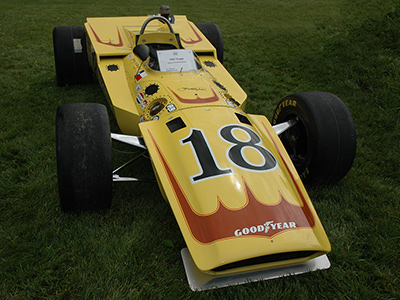
The ex-Michner 1967 Eagle at the Amelia Island Concours in 2007. Copyright conceptcarz.com 2020. Used with permission.
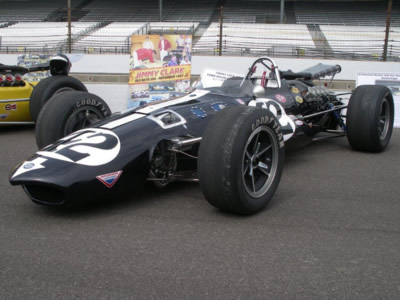
Rob Dyson's Eagle on display at Indianapolis in May 2015. Copyright Ian Blackwell 2015. Used with permission.
Walt Michner's Michner Petroleum team entered what was described as a new 1968 Eagle for Mike Mosley at the 1968 Indy 500, but photographs show it was a 66/67 Eagle. Mosley was replaced by Rick Muther before practice started, but he qualified the team's 1966 Lola T80, so the Eagle was reassigned to Ronnie Duran, and then to Bill Cheesbourg, who qualified it but was bumped. Norm Brown then took over the drive but was badly injured at Milwaukee in the accident that took the life of Ronnie Duman and destroyed the Michner Lola T80. Michner then recruited Johnny Rutherford to drive the "1968" Eagle for the rest of the season.
The Michner team had two Eagles for Rutherford in 1969, a 1966 car for ovals and this 1967 car for road races. By October 1969, possibly earlier, the 1967 car had acquired a distinctive oil radiator high on the left side of the cockpit. Mike Devin joined what was now Patrick Racing as chief mechanic for 1970 and rebuilt the 1966 car with Colt-style wedge-shaped bodywork on the sides of the car for use on ovals. It became known by the team as "Geraldine", while this more standard 1967 car, nicknamed "Old Shep", was again used primarily on road courses but was taken to the 1970 Indy 500 for Tony Adamowicz to drive. He qualified but was bumped. Rutherford then rwrecked it in practice at Langhorne in June and it was not seen again that season. In July 1971, the 1967 car was the first of the pair to be fitted with McLaren M16-style wings instead of the wedge bodywork used on "Geraldine" in 1970.
Pat Patrick reorganised the team for 1972 and the 1967 car was sold to Bentley Warren, who raced it for his #36 Bay State Racing entry in 1972. Warren retained the car for 1973 and made one last appearance at Trenton in September 1974, after which the car remained in his garage. In the early 2000s, Warren sold the car to "Eagle Partners", a consortium made up AJ Watson, Dave Thomas, Buddy Urbanski and Pat Santello, who rebuilt the car to the 1971 wedge-sided configuration used on the sister car, "Geraldine". In 2006, the restored car appeared at the Amelia Island Concours, and in 2007 it was sold at auction by Kruse (Auburn, IN) to Chuck Haines. In 2008, Haines sold it to Jim Vieira, and it appeared at an Indianapolis historic event in 2009. By early 2011, it was at John Mueller of Entrepreneur’s Motor Sports (Fresno, CA), to be restored to Richie Ginther's 1967 #42 livery. In this form, it was sold in 2013 to Rob Dyson (Millbrook, NY). On display at the offices of RACER magazine in January 2014. On display at Indianapolis in May 2015 and at the Historic Indycar Exhibition in 2016, 2017, 2018 and 2019. In December 2021, it was on display in the Saratoga Automobile Museum together with other Dyson Racing cars.
Driven by: Bill Cheesbourg, Ronnie Duman, Johnny Rutherford, Tony Adamowicz, Jim McElreath and Bentley Warren. First race: Indianapolis Raceway Park (R13), 21 Jul 1968. Total of 27 recorded races.
Identifying the 1966 and 1967 Indy Eagles
The histories of the 1966 and 1967 Eagles are still not complete, but significant progress has been made since this page was published in 2015. Although much of the early progress on this subject was based on Hungness yearbooks and mentions in the motor racing press, the more recent progress has been the result of comparing photographs of the 13 cars and identifying the small but unique features on each car. The patterns of rivets where the side skins are attached to the bulkhead behind the driver's seat are nearly all different in some way and do not change from season to season. Similarly, any duct cut into the top skin in front of the cockpit typically remains visible on the car often through to the current day, and holes in the skins left from tank fittings and mirrors are often visible. As an example, three of the cars had access panels cut into the front of the monocoque, but all those panels were slightly different to each other.
Two mysteries were previously listed here which were resolved during 2020 by detailed comparison of the cars using period photographs. Firstly, the car acquired by Jerry Hansen during the 1969 season has features around the front of the monocoque that show that it was the 1966 Eagle, chassis 201, that AAR had used in late 1967 and early 1968 for the Gurney-Weslake stock block engine. This agreed with press reports saying that the car was ex-Gurney, although those press reports incorrectly identified it as a 1967 car. The second puzzle concerned the pair of Eagles acquired by A.J. Foyt for road courses in 1967, and photographs have now shown that these were Dan Gurney's #74 entry and Smokey Yunick's #69 entry for Denny Hulme at the 1967 Indy 500. The only time Foyt entered both cars together was at the pair of races at Mosport in July 1967, where Foyt drove the ex-Yunick/Hulme car, now repainted red and entered as #14, and Joe Leonard had the ex-Gurney car still in AAR livery and entered as #4. The next time the Foyt team used an Eagle was at the Riverside 300 in November 1967; by this time the ex-Yunick/Hulme car had been sold on to the Hopkins team, and Foyt entered Jim Hurtubise in the ex-Gurney car, now repainted red and entered as #4. After this, the next known appearance of a Foyt-owned Eagle was not until 1970. This process also revealed that Bobby Unser had two different 1967 Eagles, not just one, during his four-year spell with the Leader Card team, and detailed comparison of photographs established that this extra car was chassis 207, the car used by Richie Ginther and Jerry Grant at the 1967 Indy 500.
The 1967 Eagle show car
In an interview with the Los Angeles Times on 20 June 1968, Dan Gurney mentioned that AAR had produced 26 cars to date, 19 of which had been Indy cars, two were for Formula A, four for Formula 1 plus a show car. A few months earlier, at the Chicago Auto Show which ran from 24 February to 3 March 1968 at the International Amphitheatre, an Eagle had been on display in the livery of Dan Gurney's #74 car at the 1967 Indy 500. However, it is clearly not the same car, and features on the car suggest that it had not been used in USAC racing, implying it was the show car Gurney had referenced.
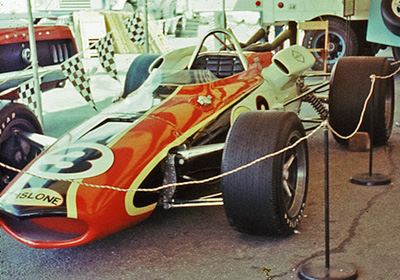
Goodyear's Eagle show car in Rislone livery at a Goodyear exhibit at Bloomington, Indiana, probably in 1970. Copyright Pete Davis (picture provided by Paul Castagnoli) 2022. Used with permission.
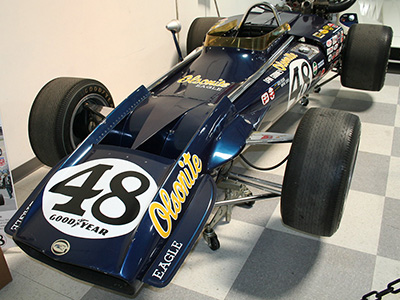
The former Goodyear Eagle show car in the Riverside Museum in March 2009. Copyright Richard Fleener 2024. Used with permission.
Between August 1967 and November 1972, a show car was used by AAR and Goodyear at various exhibitions across the US. This car appears to have been built specifically for this purpose and assigned chassis number '301'. Its existence was specifically mentioned by Dan Gurney in an interview with the Los Angeles Times on 20 June 1968.
Ian Blackwell has followed the movements of this car via newspaper reports, and first found it on display at Waukesha, Wisconsin in August 1967, then at the Chicago Auto Show which ran from 24 February to 3 March 1968 at the International Amphitheatre. The Eagle on display in Chicago was in the livery of Dan Gurney's #74 car at the 1967 Indy 500, but photographs show clearly that it was not the same car, and features on the car suggest that it had not been used in USAC racing. It can only be the show car referenced by Gurney. It continued to be used in touring US Goodyear exhibitions up to November 1968. It was then repainted into Rislone livery, impersonating Bobby Unser's successful 1967 Eagle from 1968. It toured in this form through 1969 and throughout 1970. It was then rebuilt with new outer skins to resemble a 1970 Eagle before appearing in this new form for the first time in April 1971. It toured with Goodyear again through 1971 and 1972. Its last mention was as part of Goodyear's "Meet the Hot Ones" touring exhibit in Abilene, Texas, in November 1972.
The car was then retained by Goodyear, possibly at their rebuilt exhibit room at Akron, until the mid-1980s, when Leo Mehl discussed it with collector Chuck Haines. Bought by Haines in 1987 and retained in his collection until sold to Doug Magnon in 2006. It was then on display at his Riverside International Automotive Museum from 2009, when he described it as "a show piece used by Goodyear" and "actually a '67 monocoque with a '70 body tacked on". In 2014, Magnon discussed this car with Justin Gurney and described it then as "a '67 chassis #301 that had '70 bodywork attached to make a show car for Goodyear".
After Magnon's death in early 2015, the car was sold by the Magnon family to Justin Gurney at AAR. Still at AAR's premises in 2022.
Unresolved 1967 Eagles in 1968
There is still one remaining issue to be resolved regarding the 1966/67 Eagles in 1968: the identification of 'Beagle', the Eagle that Lindsey Hopkins' crew chief Jack Beckley rebuilt in early 1968 with Brabham-style front suspension.
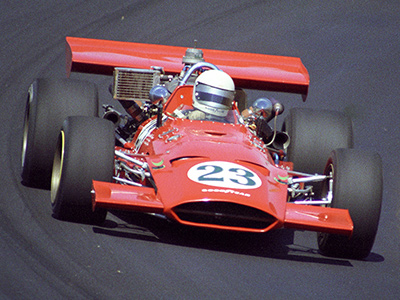
Mel Kenyon in Lindsey Hopkins' "Beagle" at Phoenix in March 1972. Copyright Mike Thomsen/www.racingpictorial.com 2022. Used with permission.
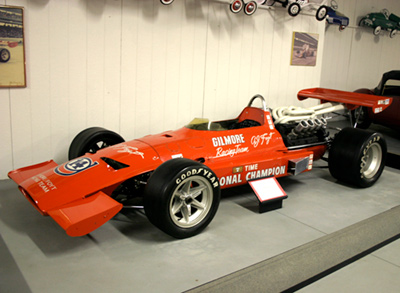
The ex-Mel Kenyon 1967 Eagle in the Gilmore Museum in 2004. Copyright Karen Parker 2014. Used with permission.
One of Lindsey Hopkins' two 1967 Eagles was rebuilt by chief mechanic Jack Beckley over the 1967/68 winter with Brabham front suspension, and named 'Beagle'. It was fitted with a turbo Offy engine and tested by Roger McCluskey at Indianapolis on 20 March 1968, but it was not present at the Indy 500 that year. Photographs then show that 'Beagle' was first raced by McCluskey at Trenton in April, then at Milwaukee in June, Langhorne in June, Langhorne again in July, Trenton in September and Michigan in October. McCluskey used his 1968 Eagle at the Indy 500 and at road races, and then moved to the team's older 1966 car for the final races of the season. Wally Dallenbach took over the Hopkins ride in 1969, with Sprite sponsorship, and 'Beagle' was used for the press announcement at the end of March, but was not seen in competition all season as Dallenbach focused on other cars in the stable. The car returned to use in 1970, as its front suspension modifications are clearly visible in photographs of the car raced by Mel Kenyon for the Hopkins team at Milwaukee in August 1970. The car returned to service as Kenyon's #23 Hopkins entry for 1972, when it had been reworked with new sidepods but still with its distinctive outboard front suspension. It was first raced in this form at Phoenix in March, then Hopkins acquired Gilmore sponsorship in mid-April, which brought Duane Glasgow into the team as chief mechanic for Wally Dallenbach. The 1967 Eagle was raced by Kenyon at Trenton in April as his #23 Gilmore entry, and was then taken to the Indy 500 as the #73 Gilmore entry as a backup car for Kenyon, where it was practiced by Kenyon (wearing #23), Dallenbach, and also by Jim McElreath, who tried but failed to qualify it. Photographs show that Kenyon raced it later that season at Michigan, Pocono, Trenton in September and Phoenix in November, and quite possibly at both Milwaukee races. This is thought to be the Eagle acquired by Jim Gilmore in Jackson, MI, and displayed on the wall in Jim Gilmore Enterprises (Kalamazoo, MI), still in Gilmore Racing colours. Photographs show that it was later in the Gilmore Car Museum (Hickory Corners, MI), now with AJ Foyt's name on it, but with the same Brabham suspension and sidepods it had in 1972.
This car was bought by Bob Donahue (Indianapolis, IN) at the Jim Gilmore Estate auction held by Kruse International at Auburn, Indiana, in September 2005. By March 2016, the car was at George Lyons' Contemporary Motorcar Ltd (Erie, PA) for body, paint, striping and lettering restoration. It then appeared at the Historic Indycar Exhibition in May 2016 but was still not mechanically complete. The restoration was finally completed by Peter Jamie in late 2018. Tragically, the car was badly damaged at the Indycar historic event in May 2019, when it hit the wall and suffered massive frontal damage. In September 2022, the repairs to the monocoque started to be documented on Youtube.
Driven by: Roger McCluskey, Mel Kenyon, Jim McElreath and Wally Dallenbach. First race: Trenton Speedway (R4), 21 Apr 1968. Total of 15 recorded races.
Later mystery 1967 Eagles
Of the seven 1967 Eagles believed to have been built, it is possible to track chassis 208 (the Hopkins/McCluskey car) through to its destruction at Dover Downs in 1969, chassis 209 (the Pacesetter Homes car) through to its major crash at Riverside in December 1968, chassis 210 (the first Leader Card car) to at least 1971, chassis 212 (the AAR #74 car) through to the present day, and chassis 214 (the AAR #42 car) through to its accident at Phoenix in November 1969. That leaves chassis 211 (Smokey Yunick car), the history of which is not yet fully understood after 1967, and chassis 214 (the Michner Petroleum car) which appears to have been unraced before 1968 and can then be traced through to 1973. If Smokey Yunick's 211 became 'the Beckley "Beagle"', as seems likely, then all seven cars can be traced at least to 1971 or to major accidents in 1968 or 1969 that are believed to have ended their racing careers.
This leaves one mystery, the Eagle acquired in 1971 or 1972 by Bob Dickson and Bruce Crower.
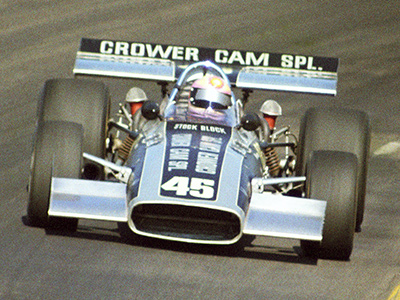
Rick Muther in Bruce Crower's Eagle-Chevy at Phoenix in November 1972. Copyright Mike Thomsen/www.racingpictorial.com 2022. Used with permission.
An Eagle acquired in 1971 or 1972 by mechanic Bob Dickson (Chula Vista, CA) for engine builder H. Bruce Crower (Jamul, CA), and fitted with Crower's 203 ci turbocharged Chevrolet V8 engine. It was entered by Crower for Rick Muther to race at Phoenix in November 1972 as the #45 Crower Cams Spl, Crower identifying it in the USAC entry forms as a 1967 Eagle but with no chassis number given. The car was also said to have gone well in tests at Ontario, and was then retained in 1973 as a backup to Crower's 1972 Eagle, which was expected to use the same engine. The 1967 Eagle was then advertised by Crower in April 1974. Its movement are then unknown for nearly 20 years, but it was still in Crower's configuration when it was bought from Jim Mahoney by Thomas W. Acker (Largo, FL) in 1993. Acker sold it in 2003 to Don and Joan Lyons (Dowagiac, Michigan), who restored the car to 1967 specification, and then offered it for sale as part of the Lyons Collection at the Gooding & Company Pebble Beach Auction in August 2009. It was bought at the auction by a private collector, who still owned the car in November 2022.
Driven by: Rick Muther and Lloyd Ruby. First race: Phoenix International Raceway (R10), 4 Nov 1972. Only one recorded race.
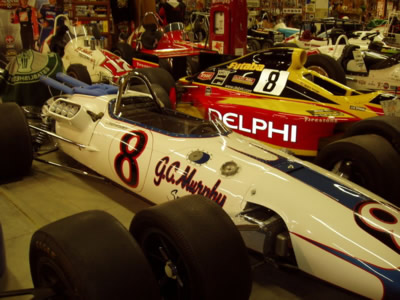
The Eagle in Roger McCluskey 1966 livery in Don Smith's collection in February 2007. Copyright Don Gould 2007. Used with permission.
According to Mike Devin, writing on Facebook in June 2018, he used the front half of the Eagle crashed by Lou Sell at Riverside in December 1968 (see the Pacesetter Homes 1967 Eagle 209) and the back of the Lindsey Hopkins Eagle crashed by Wally Dallenbach at Dover Downs in 1969 (see the Hopkins/McCluskey 1967 Eagle 208), to build a Sprite show car for Jack Beckley, long-time chief mechanic on the Lindsey Hopkins Eagles. Beckley left Hopkins in June 1970, and Don Kenyon took over the whole operation. The subsequent history of the Sprite show car is unknown, but a comparison of photographs of the front of the monocoque indicate that it is the car that spent many years in the collection of Donald E. Smith (Terre Haute, IN), a veteran sponsor and supporter of racing in Indiana. This car had reportedly been found in Brownsburg, Indiana, by John Fugate, a former employee of the IMS Museum. It had been restored in the livery of the #8 G. C. Murphy entry driven by Roger McCluskey for owner Lindsey Hopkins in 1966, and was on display in Smith's "500 Museum of Wheels" in Terre Haute, where it was featured in "Griot's Garage Treasures" on YouTube in November 2012. In June 2018, the car was auctioned, and just before the auction, it was announced that restorer Walter Goodwin had determined that it was assembled from a '66 and '67 Eagle, and was being offered on that basis. The car sold for $170,000 to Ray Skillman, an auto dealer in Greenwood, Indiana.
Acknowledgements
My thanks to Ian Blackwell for sharing the results of his very detailed research into the 1966 and 1967 Eagles. Thanks also to Michael Ferner, Simmo Iskül and Aaron Lewis for their hard work on this subject; to John Zimmerman, author of 'Dan Gurney's Eagle Racing Cars' (David Bull Publishing, 2007), the definitive history of the team, for providing information from AAR archives; to former Indianapolis Motor Speedway Museum director Ellen Bireley; and to Chuck Haines, Jerry Entin, Jeremy Hall and Tom Schultz for their help on this subject.
There is still much to understand about these cars, especially the cars that were in the Lindsey Hopkins stable, but also those in the Jerry Grant/Tommy Friedkin team and the related Marv Webster team. If you have any information that might help, or have photographs of the cars that could add to our understanding, please email Allen at allen@oldracingcars.com.
These histories were last updated on .